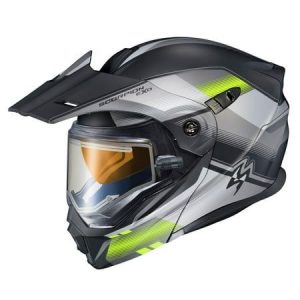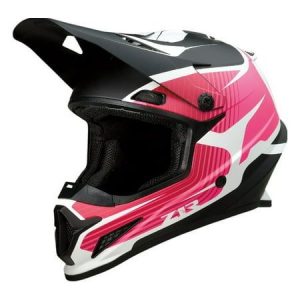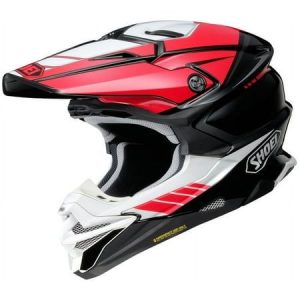Your motorcycle helmet is your lifeline. It’s the sole barrier protecting your head from serious injury in a crash. But unlike your trusty motorcycle jacket or leather boots, helmets don’t last forever. Knowing how long to keep a motorcycle helmet is crucial for ensuring optimal safety on the road.
This comprehensive guide dives deep into the factors affecting a motorcycle helmet’s lifespan. We’ll explore the telltale signs it’s time for a replacement, how to maximize your helmet’s longevity, and safety considerations to prioritize while riding. Additionally, we’ll unpack recommended replacement timelines and the importance of adhering to them for ultimate peace of mind.
Understanding the Lifespan of a Motorcycle Helmet
Several key factors influence a motorcycle helmet’s lifespan:

- Materials: The outer shell, typically made of polycarbonate or a composite blend, absorbs impact and distributes the force of a blow. Over time, exposure to harsh UV rays and extreme temperatures can degrade these materials.
- Liner: The EPS (Expanded Polystyrene) liner is the crushable foam layer that absorbs impact energy during a crash. A single significant impact can compromise the liner’s effectiveness, even if the outer shell appears undamaged.
- Comfort Padding: The removable comfort padding, while not safety-critical, can deteriorate with sweat, grime, and regular wear. Worn-out padding can affect a secure and comfortable fit, compromising helmet performance.
- Use and Storage: Frequent use, exposure to harsh elements, and improper storage can accelerate wear and tear. Leaving your helmet in direct sunlight or storing it in extreme temperatures can degrade the materials faster.
Warning Signs It’s Time to Replace Your Helmet
Even if your helmet looks good on the outside, hidden damage might lurk beneath the surface. Here are some red flags indicating it’s time for a new one:

- Visible Damage: Cracks, deep scratches, or gouges on the outer shell compromise its protective capabilities. Don’t risk your safety with a compromised helmet.
- Loose or Damaged Liner: If the EPS liner feels loose, crumbles, or shows signs of compression, it can no longer effectively absorb impact in a crash. Replace your helmet immediately.
- Worn-Out Comfort Padding: Excessively worn padding can become loose, lumpy, or lose its shape, hindering a snug fit. A secure fit is crucial for optimal helmet performance.
- Age: Regardless of condition, most helmet manufacturers recommend replacing your helmet every 5-7 years due to material degradation, even with minimal use.
Maximizing Your Motorcycle Helmet’s Lifespan
Want to get the most out of your motorcycle helmet? Here are some simple tips to extend its lifespan:
- Proper Storage: Store your helmet in a cool, dry place out of direct sunlight and extreme temperatures. A helmet bag is a wise investment to protect it from dust and scratches.
- Regular Cleaning: Wash the removable liner according to the manufacturer’s instructions. Wipe down the outer shell with a mild cleaning solution to remove dirt and grime.
- Avoid Harsh Chemicals: Steer clear of using harsh chemicals or abrasives on your helmet, as they can damage the materials.
- Inspect Regularly: Regularly inspect your helmet for any signs of damage, including loose components, worn-out padding, or cracks in the shell.
Safety First: The Importance of Certifications
When considering helmet replacement, remember that certifications ensure a helmet meets specific safety standards. Look for a Department of Transportation (DOT) or Snell Memorial Foundation (Snell) certification label inside your helmet. While these certifications don’t guarantee a helmet’s lifespan, they indicate it met safety standards at the time of manufacture.

Certification standards are updated periodically. While an older DOT- or Snell-certified helmet might have been perfectly safe when new, it may not offer the same level of protection compared to a helmet certified to the latest standards.
Recommended Replacement Timelines: Prioritizing Your Safety
While there’s no single answer to “how long should you keep a motorcycle helmet?,” safety experts generally recommend replacing your helmet every 5-7 years, even with minimal use. This timeframe accounts for the natural degradation of materials and ensures optimal protection.
Here’s a breakdown of factors influencing replacement timelines:
- Frequent Use: If you ride your motorcycle daily or for extended periods, consider replacing your helmet more frequently, every 3-5 years.
- Accidents or Drops: Even a minor drop or bump can compromise the helmet’s integrity. If your helmet experiences any impact, replace it immediately.
- Visible Damage: Any visible damage to the shell or liner necessitates immediate replacement. Don’t risk your safety with a compromised helmet.
Finding Your Perfect Fit: Selecting a New Helmet
Now that you understand the importance of timely helmet replacement, it’s time to find your perfect helmet. Here are some resources to guide you:

- Research Online: Explore online reviews and comparisons of different helmet brands and models. Consider factors like fit, comfort, safety features, and price point.
- Visit a Motorcycle Gear Store: Get fitted by a professional at a motorcycle gear store. They can ensure you get the right helmet size and style for your needs.
- Prioritize Safety: Look for helmets with DOT or Snell certifications, ideally meeting the latest safety standards.
Remember: Don’t settle for anything less than a high-quality helmet that fits comfortably and offers the features you need for safe riding.
The Value of a Quality Helmet: Ride with Peace of Mind
Replacing your motorcycle helmet might seem inconvenient, but it’s a crucial step towards maximizing your safety on the road. Here’s a reminder of the value a quality helmet offers:
- Reduced Risk of Head Injury: A properly fitted, functional helmet significantly reduces the risk of head injuries in a motorcycle accident.
- Enhanced Confidence: Knowing you’re wearing a reliable helmet can boost your confidence and focus on the road, allowing you to enjoy the ride.
- Long-Term Savings: A serious head injury can lead to devastating medical bills. Replacing your helmet every few years is a small price to pay for peace of mind.
Taking the Next Step: Invest in Your Safety Today!
Now that you’re armed with the knowledge of motorcycle helmet lifespan and the importance of replacement, you’re ready to take action. Here’s how to get started:

- Inspect Your Current Helmet: Carefully examine your helmet for any signs of damage or wear and tear.
- Consider Replacement Timeline: If your helmet is over 5-7 years old, or if it shows any signs of damage, prioritize replacing it.
- Research and Choose: Explore different helmet options online or visit a motorcycle gear store to find the perfect fit for your needs and preferences.
Ride with Confidence: Upgrade Your Helmet Today!
Don’t wait for a crash to realize the importance of a quality helmet. Ensure your safety on every ride by upgrading to a new, properly fitting motorcycle helmet today. Visit your local motorcycle gear store or browse online retailers to find the perfect helmet for you. Remember, a motorcycle helmet is an investment in your safety – ride smart and ride protected!


